Sub-ps Laser Deposited Copper Films for Application in RF Guns
Abstract
:1. Introduction
2. Materials and Methods
3. Results
4. Discussion
5. Conclusions
Author Contributions
Funding
Data Availability Statement
Acknowledgments
Conflicts of Interest
References
- Musumeci, P.; Cultrera, L.; Ferrario, M.; Filippetto, D.; Gatti, G.; Gutierrez, M.S.; Moody, J.T.; Moore, N.; Rosenzweig, J.B.; Scoby, C.M.; et al. Multiphoton Photoemission from a Copper Cathode Illuminated by Ultrashort Laser Pulses in an rf Photoinjector. Phys. Rev. Lett. 2010, 104, 84801–84804. [Google Scholar] [CrossRef] [PubMed]
- Divall, M.C.; Prat, E.; Bettoni, S.; Vicario, C.; Trisorio, A.; Schietinger, T.; Hauri, C.P. Intrinsic emittance reduction of copper cathodes by laser wavelength tuning in an rf photoinjector. Phys. Rev. Spec. Top. Accel. Beams 2015, 18, 33401–33406. [Google Scholar] [CrossRef]
- Chiadroni, E.; Bacci, A.; Bellaveglia, M.; Boscolo, M.; Castellano, M.; Cultrera, L.; diPirro, G.; Ferrario, M.; Ficcadenti, L.; Filippetto, D.; et al. The SPARC linear accelerator based terahertz source. Appl. Phys. Lett. 2013, 102, 94101–94105. [Google Scholar] [CrossRef]
- Scifo, J.; Alesini, D.; Anania, M.P.; Bellaveglia, M.; Bellucci, S.; Biagioni, A.; Bisesto, F.; Cardelli, F.; Chiadroni, E.; Cianchi, A.; et al. Nano-machining surface analysis and emittance measurements of a copper photocathode at SPARC_LAB. Nucl. Instrum. Methods Phys. Res. Sect. A 2018, 909, 233–238. [Google Scholar] [CrossRef]
- Maldonado, J.R.; Liu, Z.; Dowell, D.H.; Kirby, R.E.; Sun, Y.; Pianetta, P.; Pease, F. Robust CsBr/Cu photocathodes for the linac coherent light source. Phys. Rev. ST Accel. Beams 2008, 11, 060702. [Google Scholar] [CrossRef]
- Zhou, F.; Brachmann, A.; Decker, F.-J.; Emma, P.; Gilevich, S.; Iverson, R.; Stefan, P.; Turner, J. High-brightness electron beam evolution following laser-based cleaning of a photocathode. Phys. Rev. ST Accel. Beams 2012, 15, 090703. [Google Scholar] [CrossRef]
- Lorusso, A.; Gontad, F.; Solombrino, L.; Chiadroni, E.; Broitman, E.; Perrone, A. Tight comparison of Mg and Y thin film photocathodes obtained by the pulsed laser deposition technique. Nucl. Instrum. Meth. Phys. Res. A 2016, 836, 57–60. [Google Scholar] [CrossRef]
- Wang, X.J.; Babzien, M.; Chang, X.Y.; Lynch, D.; Pjerov, S.; Woodle, M.; Wu, Z. Band high duty photo-injection system. In Proceedings of the 19th IEEE Particle Accelerator Conference, Chicago, IL, USA, 18–22 June 2001; Volume 1822. [Google Scholar]
- Qian, J.; Murphy, J.B.; Shen, Y.; Tang, C.X.; Wang, X.J. Surface photoemission in a high-brightness electron beam radio frequency gun. Appl. Phys. Lett. 2010, 97, 253504. [Google Scholar] [CrossRef]
- Wang, X.J.; Srinivasan-Rao, T.; Batchelor, K.; Ben-Zvi, I.; Fischer, J. Measurements on photoelectrons from a magnesium cathode in a microwave electron gun. Nucl. Instrum. Meth. Phys. Res. A 1995, 356, 159–166. [Google Scholar] [CrossRef]
- Srinivasan-Rao, T.; Schill, J.; Ben-Zvi, I.; Woodle, M. Sputtered magnesium as a photocathode material for rf injectors. Rev. Sci. Instrum. 1998, 69, 2292–2296. [Google Scholar] [CrossRef]
- Perrone, A.; D’Elia, M.; Gontad, F.; DiGiulio, M.; Maruccio, G.; Cola, A.; Stankova, N.E.; Kovacheva, D.G.; Broitman, E. Non conventional photocathodes based on Cu thin films deposited on Y substrate by sputtering. Nucl. Instrum. Methods Phys. Res. Sect. A 2014, 752, 27–32. [Google Scholar] [CrossRef]
- Srinivasan-Rao, T.; Fischer, J.; Tsang, T. Photoemission studies on metals using picosecond ultraviolet laser pulses. J. Appl. Phys. 1991, 69, 3291–3296. [Google Scholar] [CrossRef]
- Cultrera, L.; Gatti, G.; Tazzioli, F.; Perrone, A.; Miglietta, P.; Ristoscu, C.; Orlanducci, S.; Fiori, A. Mg based photocathodes for high brightness RF photoinjectors. Appl. Surf. Sci. 2007, 253, 6531–6534. [Google Scholar] [CrossRef]
- Lorusso, A.; Trovò, M.; Demidovich, A.; Cinquegrana, P.; Gontad, F.; Broitman, E.; Chiadroni, E.; Perrone, A. Pulsed laser deposition of yttrium photocathode suitable for use in radio-frequency guns. Appl. Phys. A 2017, 123, 1–7. [Google Scholar] [CrossRef]
- Cultrera, L.; Gatti, G.; Miglietta, P.; Tazzioli, F.; Perrone, A.; Moody, J.T.; Musumeci, P. Electron emission characterization of Mg photocathode grown by Pulsed Laser Deposition within an S-band RF gun. Phys. Rev. Spec. Top.-Accel. Beams 2009, 12, 043502. [Google Scholar] [CrossRef]
- Lorusso, A.; Anni, M.; Caricato, A.P.; Gontad, F.; Perulli, A.; Taurino, A.; Perrone, A.; Chiadroni, E. Deposition of Y thin films by nanosecond UV pulsed laser ablation for photocathode application. Thin Solid Film. 2016, 603, 441–445. [Google Scholar] [CrossRef]
- Gontad, F.; Lorusso, A.; Panareo, M.; Monteduro, A.G.; Maruccio, G.; Broitman, E.; Perrone, A. Nanomechanical and electrical properties of Nb thin films deposited on Pb substrates by pulsed laser deposition as a new concept photocathode for superconductor cavities. Nucl. Instrum. Methods Phys. Res. Sect. A 2015, 84, 132–136. [Google Scholar] [CrossRef]
- Lorusso, A. Overview and development of metallic photocathodes prepared by laser ablation. Appl. Phys. A 2013, 110, 869–875. [Google Scholar] [CrossRef]
- Cultrera, L.; Grigorescu, S.; Gatti, G.; Miglietta, P.; Tazzioli, F.; Perrone, A.; Nanosci, J. Photoelectron emission from yttrium thin films prepared by pulsed laser deposition. J. Nanosci. Nanotechnol. 2009, 9, 1585–1588. [Google Scholar] [CrossRef]
- Lorusso, A.; Cola, A.; Gontad, F.; Koutselas, I.; Panareo, M.; Vainos, N.A.; Perrone, A. New configuration of metallic photocathodes prepared by pulsed laser deposition. Nucl. Instrum. Methods Phys. Res. Sect. A 2013, 724, 72–75. [Google Scholar] [CrossRef]
- Saenger, K.L. Angular Distribution of Ablated Material, in Pulsed Laser Deposition of Thin Films. In Pulsed Laser Deposition of Thin Films; Chrisey, D.B., Hubler, G.K., Eds.; John Wiley&Sons: New York, NY, USA, 1994; p. 199 and references therein. [Google Scholar]
- Na, L.; Xiaochang, N.; Ru, H.; Tony, D.; Xuan, W.; Amoruso, S.; Ching-yue, W. The spatial detection on distribution of metal nano-particles during femtosecond laser ablation. Proc. SPIE 2009, 7381, 738109. [Google Scholar]
- Donnelly, T.; Lunney, J.G.; Amoruso, S.; Bruzzese, R.; Wang, X.; Ni, X. Angular distributions of plume components in ultrafast laser ablation of metal targets. Appl. Phys. A 2010, 100, 569–574. [Google Scholar] [CrossRef]
- Anoop, K.K.; Polek, M.P.; Bruzzese, R.; Amoruso, S.; Harilal, S.S. Multidiagnostic analysis of ion dynamics in ultrafast laser ablation of metals over a large fluence range. J. Appl. Phys. 2015, 117, 83108–83109. [Google Scholar] [CrossRef]
- Toftmann, B.; Doggett, B.; Budtz-Jørgensen, C.; Schou, J.; Lunney, J.G. Femtosecond ultraviolet laser ablation of silver and comparison with nanosecond ablation. J. Appl. Phys. 2013, 113, 083304. [Google Scholar] [CrossRef]
- Amoruso, S.; Bruzzese, R.; Wang, X.; Nedialkov, N.N.; Atanasov, P.A. Femtosecond laser ablation of nickel in vacuum. J. Phys. D Appl. Phys. 2007, 40, 331–340. [Google Scholar] [CrossRef]
- Harilal, S.S.; Diwakar, P.K.; Polek, M.P.; Phillips, M.C. Morphological changes in ultrafast laser ablation plumes with varying spot size. Opt. Express 2015, 23, 15608–15615. [Google Scholar] [CrossRef]
- Garrelie, F.; Loir, A.S.; Donnet, C.; Rogemond, F.; LeHarzic, R.; Belin, M.; Audouard, E.; Laporte, P. Femtosecond pulsed laser deposition of diamond-like carbon thin films for tribological applications. Surf. Coat. Technol. 2003, 163–164, 306–312. [Google Scholar] [CrossRef]
- Loir, A.S.; Garrelie, F.; Donnet, C.; Rogemond, F.; Subtil, J.L.; Forest, B.; Belin, M.; Laporte, P. Towards the deposition of tetrahedral diamond-like carbon films on hip joints by femtosecond pulsed laser ablation. Surf. Coat. Technol. 2004, 188–189, 728–734. [Google Scholar] [CrossRef]
- Gilicze, B.; Barna, A.; Kovács, Z.; Szatmári, S.; Földes, I.B. Plasma mirrors for short pulse KrF lasers. Rev. Sci. Instrum. 2016, 87, 083101. [Google Scholar] [CrossRef]
- Simon, P.; Ihlemann, J. Ablation of submicron structures on metals and semiconductors by femtosecond UV-laser pulses. Appl. Surf. Sci. 1997, 109–110, 25–29. [Google Scholar] [CrossRef]
- Komashko, A.M.; Feit, M.D.; Rubenchik, A.M. Modeling of long-term behavior of ablation plumes produced with ultrashort laser pulses. Proc. SPIE 2000, 3935, 97–103. [Google Scholar]
- Jordan, R.; Cole, D.; Lunney, J.G.; Mackay, K.; Givord, D. Pulsed laser ablation of copper. Appl. Surf. Sci. 1995, 86, 24–28. [Google Scholar] [CrossRef]
- Shin, B.S.; Oh, J.Y.; Sohn, H. Theoretical and experimental investigations into laser ablation of polyimide and copper films with 355-nm Nd:YVO4 laser. J. Mater. Process. Technol. 2007, 187–188, 260–263. [Google Scholar] [CrossRef]
- Tang, G.; Abdolvand, A. Laser-assisted highly organized structuring of copper. Opt. Mater. Express 2011, 1, 1425–1432. [Google Scholar] [CrossRef]
- Zhang, W.; Yao, Y.L.; Chen, K. Modelling and Analysis of UV Laser Micromachining of Copper. Int. J. Adv. Manuf. Technol. 2001, 18, 323–331. [Google Scholar] [CrossRef]
- Tunna, L.; Kearns, A.; O’Neill, W.; Sutcliffe, C.J. Micromachining of copper using Nd:YAG laser radiation at 1064, 532 and 355 nm wavelengths. Opt. Laser Technol. 2001, 33, 135–143. [Google Scholar] [CrossRef]
- Lorusso, A.; Nassisi, V.; Buccolieri, A.; Buccolieri, G.; Castellano, A.; Leo, L.S.; DiGiulio, M.; Torrisi, L.; Caridi, F.; Borrielli, A. Laser ablation threshold of culturalheritage metals. Radiat. Eff. Defects Solids 2008, 163, 325–329. [Google Scholar] [CrossRef]
- Müller, F.; Mann, K.; Simon, P.; Bernstein, J.S.; Zaal, G.J. A Comparative Study of Deposition of Thin Films by Laser Induced PVD with Femtosecond and Nanosecond Laser Pulses. Proc. SPIE 1993, 1858, 464–475. [Google Scholar]
- Földes, I.B.; Bakos, J.; Gal, K.; Juhász, Z.; Kedves, M.Á.; Kocsis, G.; Szatmari, S.; Veres, G. Properties of high harmonics generated by ultrashort UV laser pulses on solid surfaces. Laser Phys. 2000, 10, 264–269. [Google Scholar]
- Byskov-Nielsen, J.; Savolainen, J.M.; Snogdahl, M.; Balling, P. Ultra-short pulse laser ablation of copper, silver and tungsten: Experimental data and two-temperature model simulations. Appl. Phys. A 2011, 103, 447–453. [Google Scholar] [CrossRef]
- Mannion, P.T.; Magee, J.; Coyne, E.; O’Connor, G.M.; Glynn, T.J. The effect of damage accumulation behaviour on ablation thresholds and damage morphology in ultrafast laser micro-machining of common metals in air. Appl. Surf. Sci. 2004, 233, 275–287. [Google Scholar] [CrossRef]
- Momma, C.; Nolte, S.; Chichkov, B.N.; Alvensleben, F.V.; Tünnermann, A. Precise laser ablation with ultrashort pulses. Appl. Surf. Sci. 1997, 109-110, 15–19. [Google Scholar] [CrossRef]
- Cheng, C.W.; Wang, S.Y.; Chang, K.P.; Chen, J.K. Femtosecond laser ablation of copper at high laser fluence: Modeling and experimental comparison. Appl. Surf. Sci. 2016, 361, 41–48. [Google Scholar] [CrossRef]
- Gamaly, E.G.; Rode, A.V.; Luther-Davies, B.; Tikhonchuk, V.T. Ablation of solids by femtosecond lasers: Ablation mechanism and ablation thresholds for metals and dielectrics. Phys. Plasmas 2002, 9, 949–957. [Google Scholar] [CrossRef]
- Axente, E.; Noël, S.; Hermann, J.; Sentis, M.; Mihailescu, I.N. Subpicosecond laser ablation of copper and fused silica: Initiation threshold and plasma expansion. Appl. Surf. Sci. 2009, 255, 9734–9737. [Google Scholar] [CrossRef]
- Hashida, M.; Semerok, A.F.; Gobert, O.; Petite, G.; Izawa, Y.; Wagner, J.F. Ablation threshold dependence on pulse duration for copper. Appl. Surf. Sci. 2002, 197–198, 862–867. [Google Scholar] [CrossRef]
- Gontad, F.; Lorusso, A.; Klini, A.; Manousaki, A.; Perrone, A.; Fotakis, C. Growth of poly-crystalline Cu films on Y substrates by picosecond pulsed laser deposition for photocathode applications. Nucl. Instrum. Methods Phys. Res. Sect. A 2015, 799, 70–74. [Google Scholar] [CrossRef]
- Preuss, S.; Demchuk, A.; Stuke, M. Sub-picosecond UV laser ablation of metals. Appl. Phys. A 1995, 61, 33–37. [Google Scholar] [CrossRef]
- Weaver, I.; Lewis, C.L.S. Polar distribution of ablated atomic material during the pulsed laser deposition of Cu in vacuum: Dependence on focused laser spot size and power density. J. Appl. Phys. 1996, 79, 7216–7222. [Google Scholar] [CrossRef]
- Eliezer, S.; Eliaz, N.; Grossman, E.; Fisher, D.; Gouzman, I.; Henis, Z.; Pecker, S.; Horovitz, Y.; Fraenkel, M.; Maman, S.; et al. Synthesis of nanoparticles with femtosecond laser pulses. Phys. Rev. B 2004, 69, 144119. [Google Scholar] [CrossRef]
- Singh, R.K.; Narayan, J. Pulsed-laser evaporation technique for deposition of thin films: Physics and theoretical model. Phys. Rev. B 1990, 41, 8843–8859. [Google Scholar] [CrossRef] [PubMed]
- Teubner, U.; Uschmann, I.; Gibbon, P.; Altenbernd, D.; Förster, E.; Feurer, T.; Theobald, W.; Sauerbrey, R.; Hirst, G.; Key, M.; et al. Absorption and hot electron production by high intensity femtosecond uv-laser pulses in solid targets. Phys. Rev. E 1996, 54, 4167–4177. [Google Scholar] [CrossRef] [PubMed]
- Tóth, Z.; Hopp, B.; Klebniczki, J.; Kresz, N.; Bor, Z.; Anglos, D.; Kalpouzos, C.; Fotakis, C. Expansion velocities of 0.5 ps KrF excimer laser induced plasma by Doppler-shift analysis of pump and probe measurements. Appl. Phys. A 2004, 79, 1287–1290. [Google Scholar] [CrossRef]
- Haverkamp, J.; Mayo, R.M.; Bourham, M.A.; Narayan, J.; Jin, C.; Duscher, G. Plasma plume characteristics and properties of pulsed laser deposited diamond-like carbon films. J. Appl. Phys. 2003, 93, 3627–3634. [Google Scholar] [CrossRef]
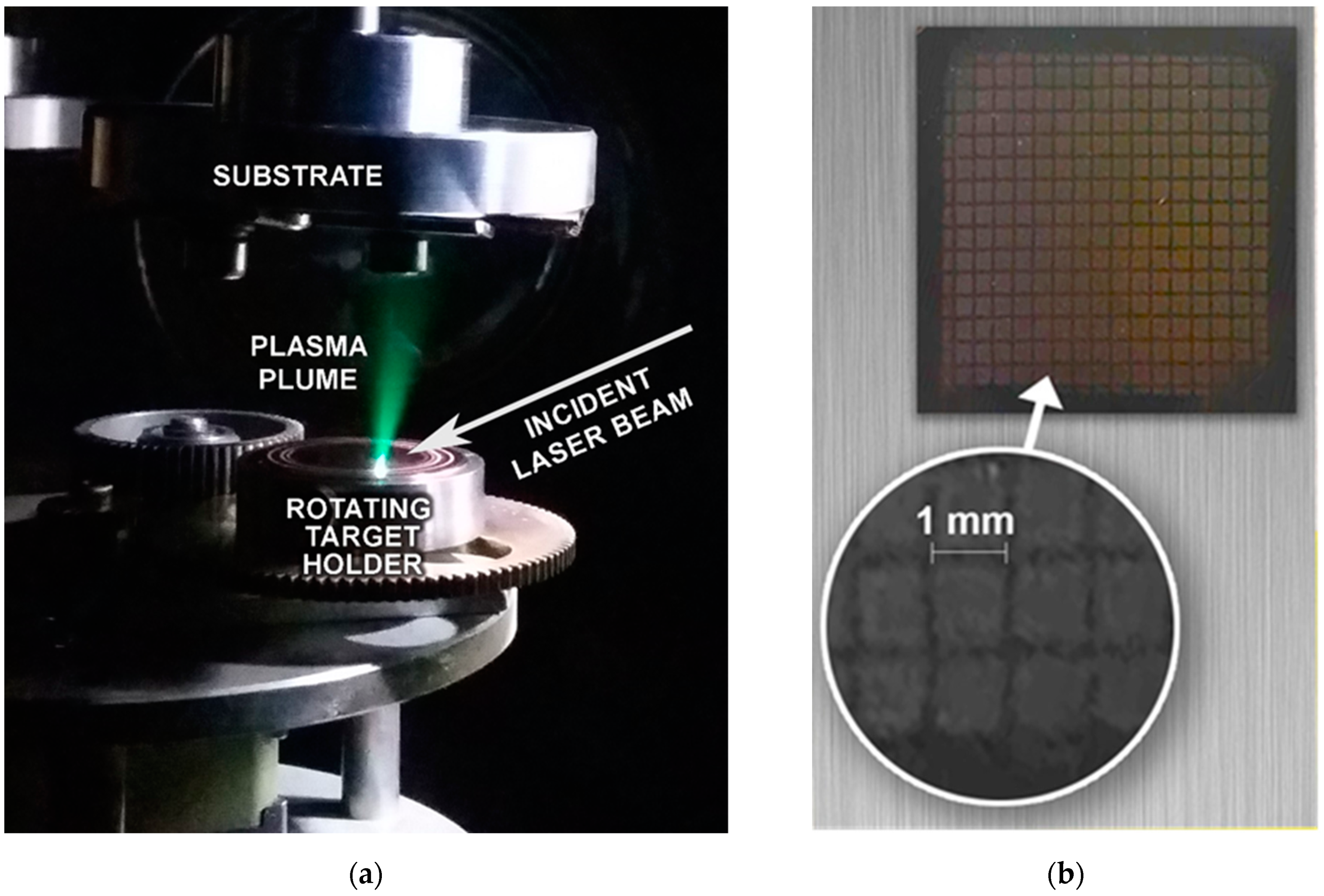
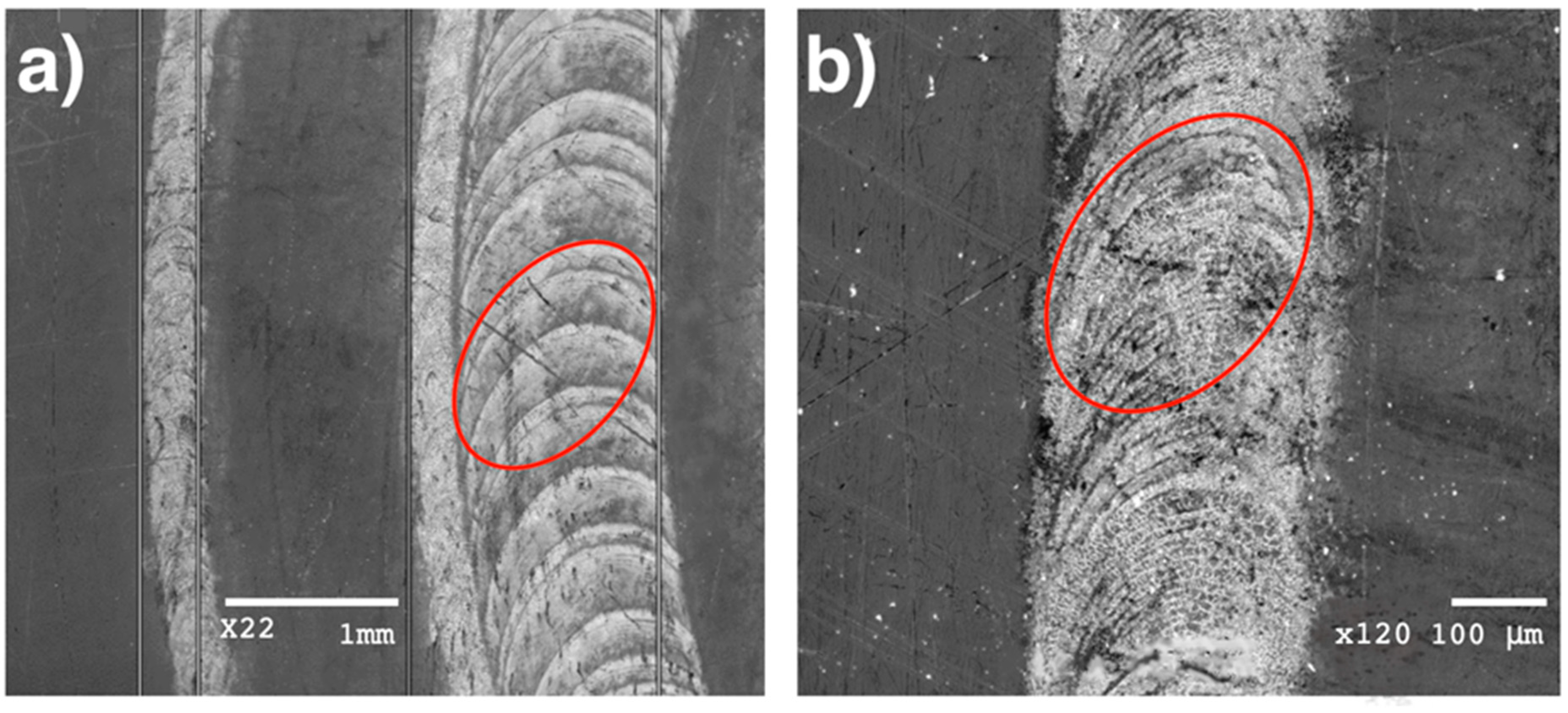

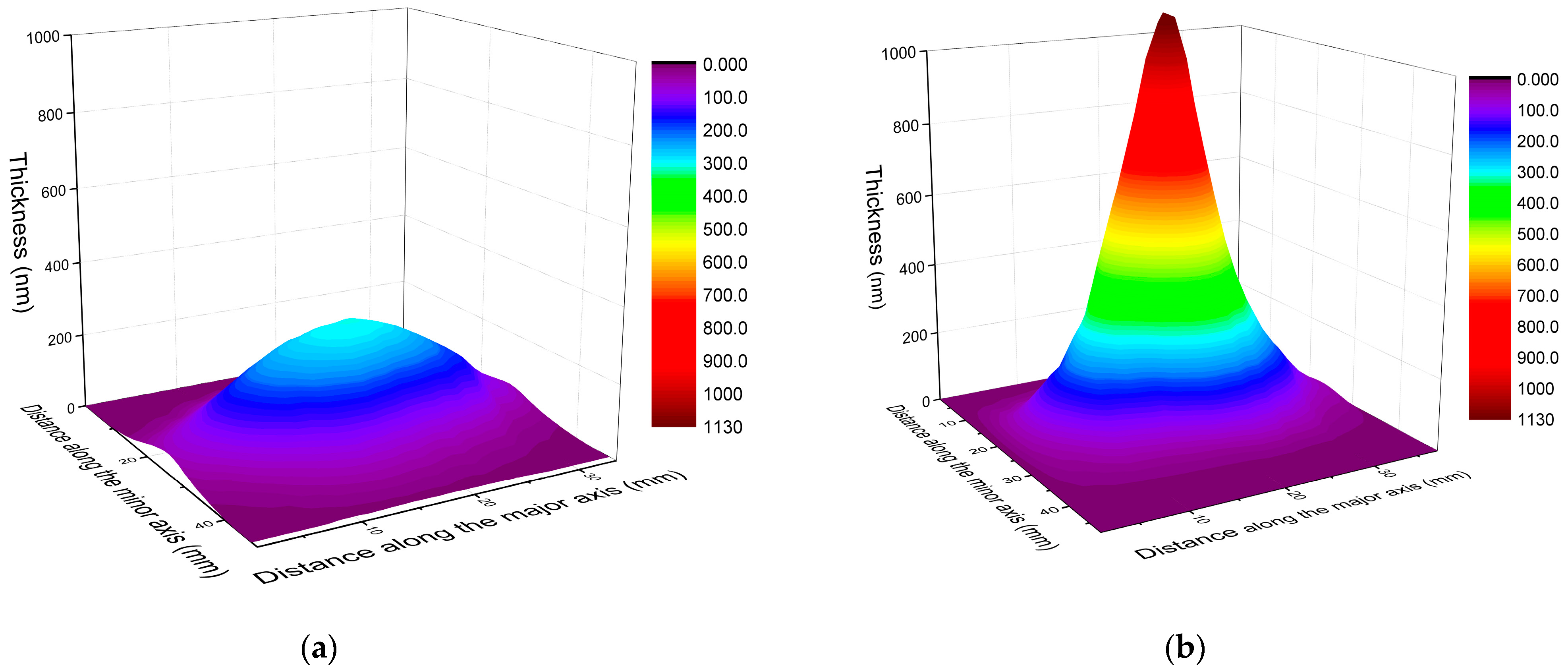
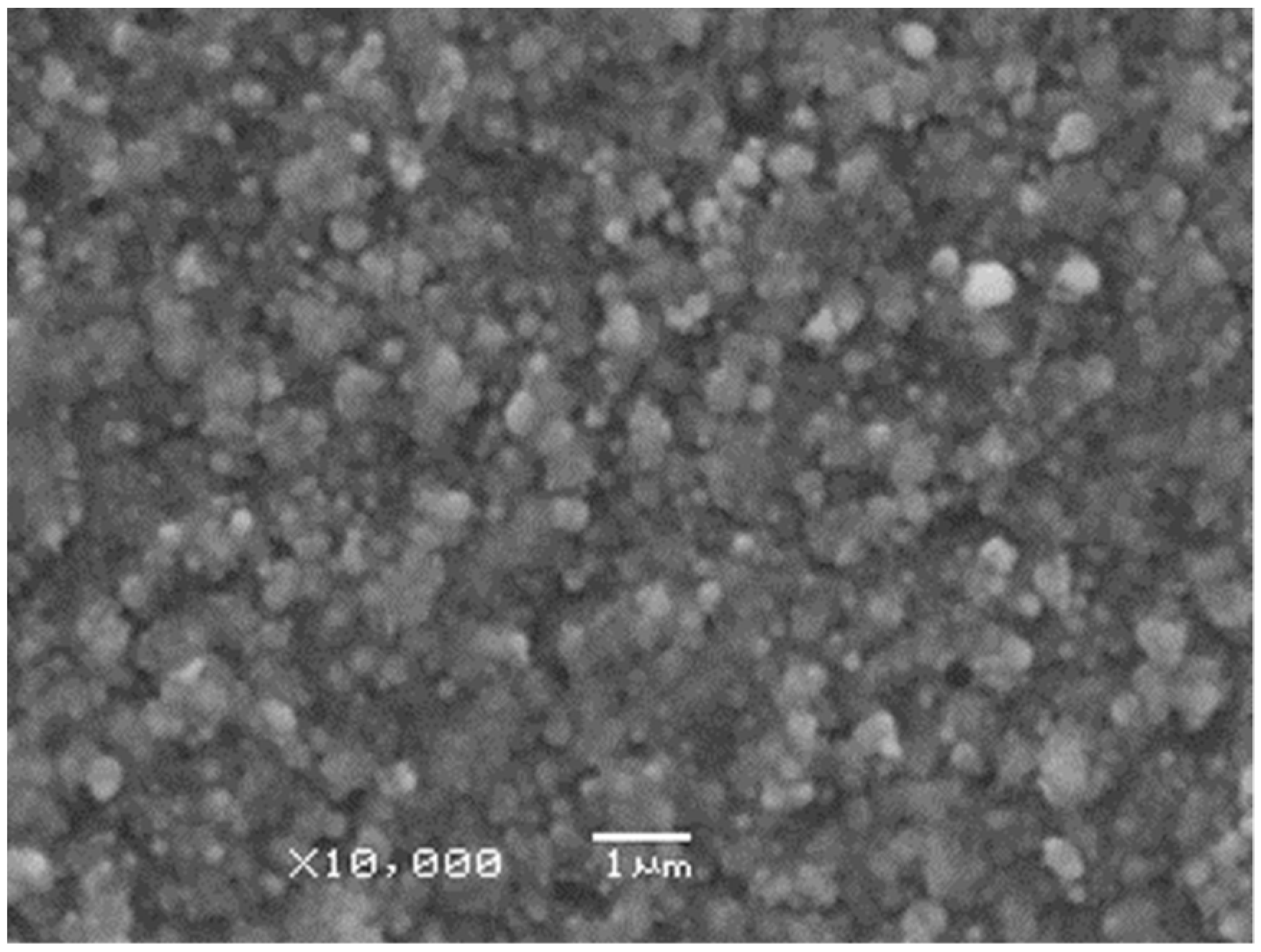


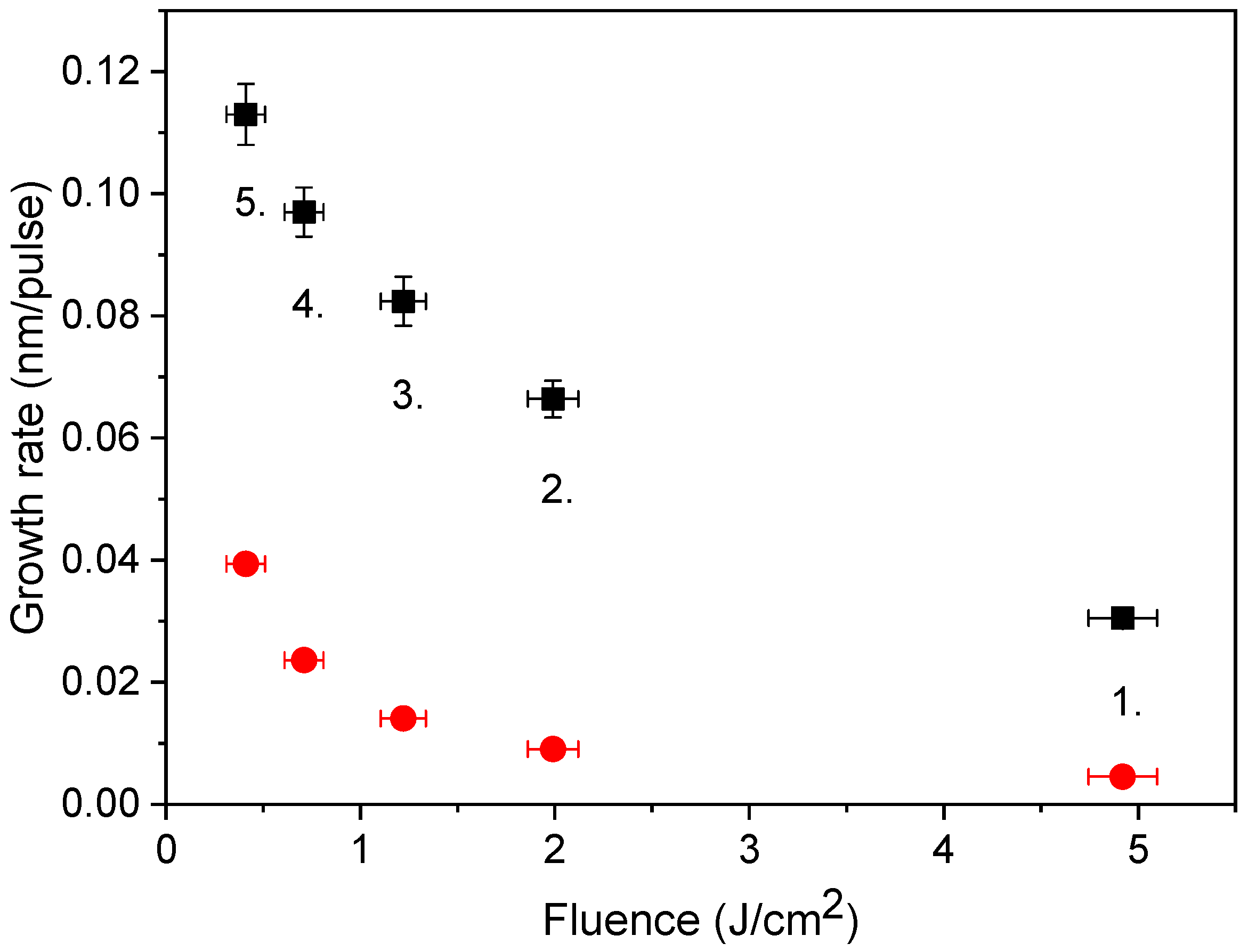
| Lens Position | 1 | 2 | 3 | 4 | 5 | |
|---|---|---|---|---|---|---|
| Main Pulse | Area (mm2) | 0.085 | 0.21 | 0.34 | 0.59 | 1.01 |
| Fluence (J/cm2) | 4.92 | 1.99 | 1.22 | 0.71 | 0.41 | |
| Intensity (W/cm2) | 8.2 × 1012 | 3.3 × 1012 | 2.0 × 1012 | 1.2× 1012 | 0.7 × 1012 | |
| ASE | Area (mm2) | 0.30 | 0.90 | 1.48 | 2.16 | 3.30 |
| Fluence (J/cm2) | 0.037 | 0.012 | 0.0074 | 0.0051 | 0.0033 | |
| Intensity (W/cm2) | 4.9 × 106 | 1.6 × 106 | 9.9 × 106 | 6.8 × 106 | 4.4 × 106 | |
Disclaimer/Publisher’s Note: The statements, opinions and data contained in all publications are solely those of the individual author(s) and contributor(s) and not of MDPI and/or the editor(s). MDPI and/or the editor(s) disclaim responsibility for any injury to people or property resulting from any ideas, methods, instructions or products referred to in the content. |
© 2023 by the authors. Licensee MDPI, Basel, Switzerland. This article is an open access article distributed under the terms and conditions of the Creative Commons Attribution (CC BY) license (https://creativecommons.org/licenses/by/4.0/).
Share and Cite
Lorusso, A.; Kovács, Z.; Gilicze, B.; Szatmári, S.; Perrone, A.; Szörényi, T. Sub-ps Laser Deposited Copper Films for Application in RF Guns. Materials 2023, 16, 1267. https://doi.org/10.3390/ma16031267
Lorusso A, Kovács Z, Gilicze B, Szatmári S, Perrone A, Szörényi T. Sub-ps Laser Deposited Copper Films for Application in RF Guns. Materials. 2023; 16(3):1267. https://doi.org/10.3390/ma16031267
Chicago/Turabian StyleLorusso, Antonella, Zsolt Kovács, Barnabás Gilicze, Sándor Szatmári, Alessio Perrone, and Tamás Szörényi. 2023. "Sub-ps Laser Deposited Copper Films for Application in RF Guns" Materials 16, no. 3: 1267. https://doi.org/10.3390/ma16031267
APA StyleLorusso, A., Kovács, Z., Gilicze, B., Szatmári, S., Perrone, A., & Szörényi, T. (2023). Sub-ps Laser Deposited Copper Films for Application in RF Guns. Materials, 16(3), 1267. https://doi.org/10.3390/ma16031267






